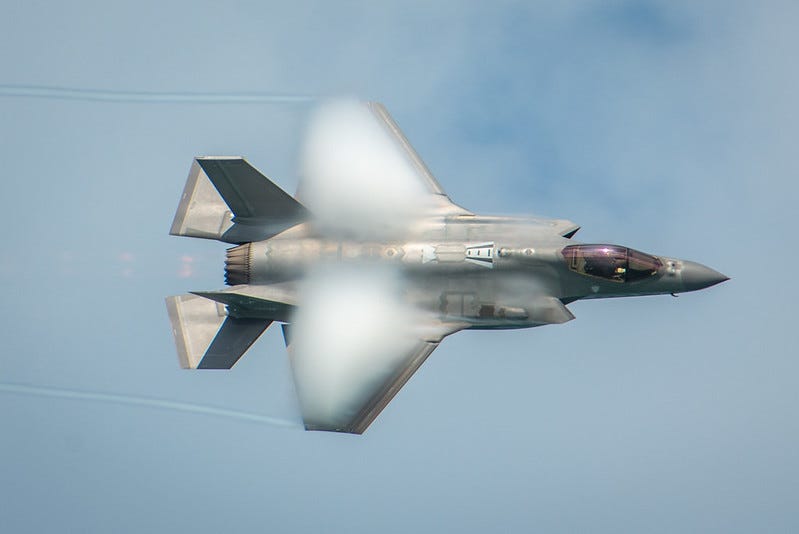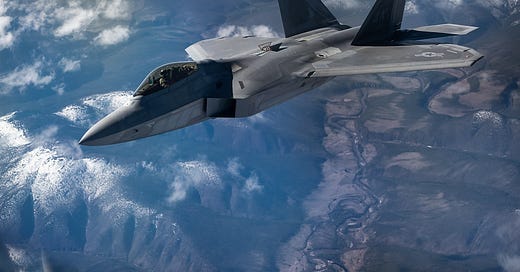I’m Paul Musgrave, a political scientist and writer. This is Systematic Hatreds, my newsletter about my thoughts regarding politics and the study of politics. The newsletter takes its title from a line in The Education of Henry Adams:
Politics, as a practice, whatever its professions, had always been the systematic organization of hatreds.
This week, we’re talking about the politics of the images the U.S. government produces of its work in international relations.
The Military-Photographic Complex
The prospect of domination of the nation's scholars by Federal employment, project allocations, and the power of money is ever present and is gravely to be regarded.
—Dwight D. Eisenhower, Farewell Speech, 1961
When Eisenhower warned that the Cold War meant the military dominated everything, I don’t think he had in mind my Keynote slides. But in a twist, the story the United States government tells the world about itself and its own doings is phenomenally militarized—and because of a quirk of copyright law, that means that much of the visual public domain of the 21st century is a product of the security state.
Okay. Let’s back up.

I care a lot about my lecture slides, and I put a lot of time into making them visually appealing and representative. One reason I care is that I want them to be maximally reusable (only a fool can fail to see that the pivot to video is coming for higher ed sooner or later), and so that means I also care a lot about ensuring that all the images I use are properly licensed. Since I have a budget of, essentially, zero dollars, that means I spend a lot of time on sites that provide free, copyright-free like Pexels, Unsplash, Wikipedia, Flickr’s Creative Commons search, and, given my subject matter, U.S. government Web sites.
Anything produced by the U.S. federal government cannot be copyrighted (state and local governments are a different story). The U.S. federal government also, you may have noticed, produces a lot of intellectual property—all of it, from Census reports to congressional floor speeches to NASA photographs of the Earth to the CIA World Factbook, entering the public domain.
An underappreciated part of this is the audiovisual output of the Department of Defense and how it shapes the literal images of international relations we can use.

The Defense Department employs a large number of military photographers (I don’t know how many, but it must be several hundred at least). Everything they produce is in the public domain. And they produce a lot, made available via Defense.Gov, DVIDS, official Flickr sites, and other outlets.
Much of what they put out is striking, often exciting, even, sometimes, beautiful. They’re frequently incredibly well composed. The DoD’s collection is almost certainly the largest visual corpus about the workings of a foreign policy-relevant topic anywhere. And the pictures are all free.

There are a few other U.S. government agencies that have strong visual presences. NASA, whose photos of, you know, the universe, usually look good, pretty much has a cheat code. The White House tends to have a good visual presence on Flickr. It probably reached its apogee under Pete Souza’s tenure during the Obama administration, and the first year or so of the Trump administration was terrible (amateurishly composed, few in numbers), but by the end even 45 was doing well. And the Biden administration has started strong, even though Covid has made crowd shots a little harder.

But you know who does poorly? Basically everyone else. Okay, it makes sense that CIA doesn’t have a great visual presence on social media. But it’s a shame that the U.S. State Department has a weak visual presence—ooh, it’s a stand-up shot of someone in a suit in a briefing room. (Shout-out to the US mission in Geneva, though, which does pretty well.) The legislative branch is mediocre, reflecting its decentralized nature—the House provides great photographs of the Capitol building, but not of members actually doing work. That’s up to individual members and committees, who can’t individually afford the kind of talent it takes to do great photography on deadline. But even Congress fares better than the “money agencies”. The Treasury Department apparently gave up on updating its Flickr in 2016. USAID offers a bunch of screen captures of Zoom (okay, maybe Webex) meetings. The US Trade Representative has never even bothered to upload anything.
Compare that to what you can get on DVIDS and … it’s no comparison. If you want to visually represent the civilian side of the U.S. government, especially the civilian side of foreign policy, you’re out of luck.
Some of that has to do with the fact that the civilians just don’t have as cool of toys as the Defense Department does. But more of it has to do with the wild disparity in funding for civilian agencies and military/security issues. After all, representing the United States isn’t so boring that you can’t take any good pictures of it.
It may not be literally true that the Defense Department has more band members than the State Department has diplomats, but those numbers are in the same ballpark—and that gives you a sense of the disparity of resources put into war and peace, respectively. The visual disparity is even more striking.

And all of this brings us back to how this disparity affects the public domain. The images and videos in the public domain are the tools that we have to tell our story (unless our resources include a Getty subscription). They’re overwhelmingly militarized. And that means it’s easier to show—and tell—a militarized story.
This is not, actually, a niche complaint. In a visual world, being on Flickr—or more modern social networks, from TikTok to Instagram—is how people communicate. Even Chechen leader Ramzan Kadyrov understands this (or did, before he was suspended). Bolstering how the U.S. presents its civilian foreign policy—and civilian agencies more generally—would help to tell different stories, both to the world and to us.
What I’m Writing
This week, you can find more of my writing at The New Rambler, where I review Oil Powers: A History of the U.S.-Saudi Alliance by Victor McFarland.
I really enjoyed this book, which I found pretty revealing about the myths—and facts—of the U.S.-Saudi relationship. I also took the opportunity to make an intervention in some of the debates roiling D.C. about what an “alliance” is, what U.S. policy toward alliances should be, and why we need clearer thinking about nondemocratic U.S. allies. From the conclusion:
It’s likely that the U.S. relationship with Saudi Arabia will face increasing turmoil, but that has little to do with the moral virtues—or vices—of rulers in either country’s capital. The shift away from fossil fuels will itself likely make the Middle East of less immediate concern to U.S. policymakers. Simultaneously, China’s growing dependence on imported oil, and its similarly growing wealth and power, will provide Saudi Arabia with something its rulers have not had for decades: a viable outside option for a superpower patron.
McFarland may therefore be right that the established U.S.-Saudi order may not last. And it’s conventional wisdom in some quarters at least that the alliance has been more of a cost than a burden. Perhaps—but perhaps not. Observers might regard the bloody record of other periods of great-power transition and evince a little less eagerness to see what the future holds.
I really enjoyed the book and writing this review; The New Rambler is a great publication and deserves more notice.



